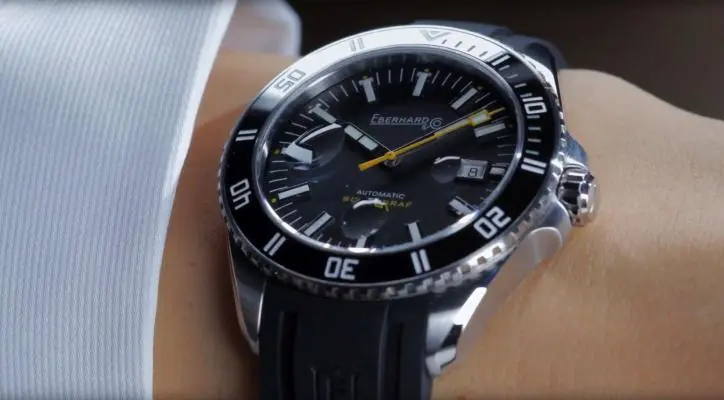
The 2016 Eberhard & Co. Scafograf 300 (ref. 41034) looks like a faithful recreation of the classic Scafograf from the 1950s. Offering you a nice combination of a robust Swiss-made movement, adequate water resistance rating of 300 meters, and an elegant exterior, it is mildly overpriced but will probably be successful in the long run when all sorts of discounts and rebates kick in.
Overall Impression
Although Eberhard & Co. has always tried to play it safe when it came to industrial design, they have had a thing for being original. While most of their timekeepers were never as radical as, for example, their Chrono4 line of sporty chronographs that featured four linearly positioned sub-dials, they weren’t generic either.
Still, there is a huge spike of interest in all things vintage, and, for a smaller brand like Eberhard & Co. letting this wave just dissipate was not an option: you have to ride the wave, not ignore it to stay afloat. Luckily, their timekeepers from the 1950s and 1960s, too, had a character of their own, although -let’s be honest about that- by no means revolutionary. Offering a sort of homage to a classic line that wouldn’t look like yet another Submariner-lookalike wasn’t that difficult after all.
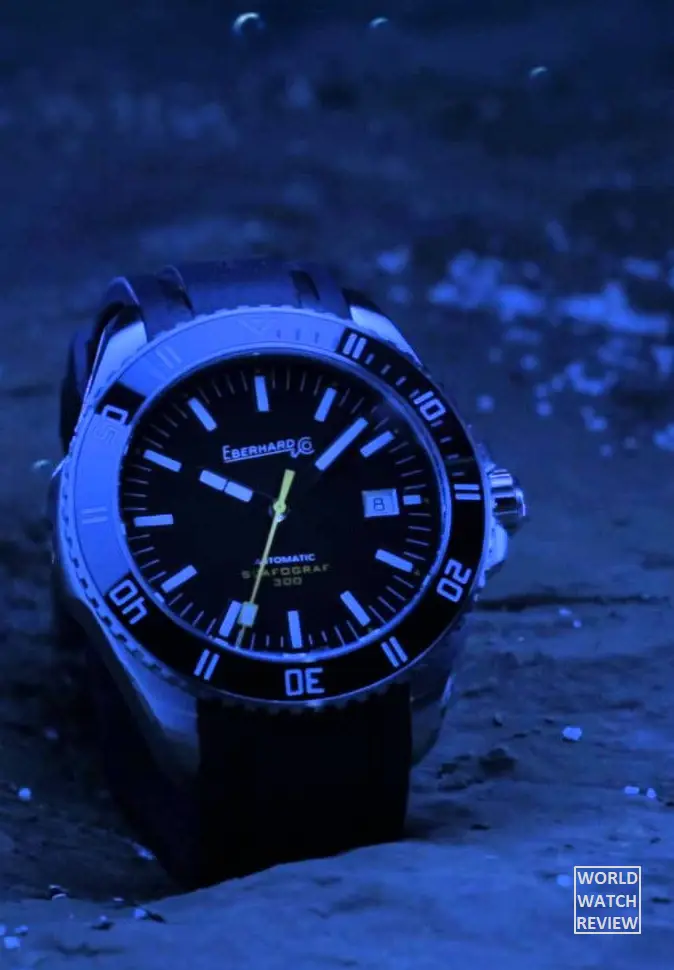
The new version looks a bit classier than the original thanks to a better finish of the stainless steel case, a more refined bezel with black ceramic inlay, and a more comfortable (although optional) steel bracelet. Still, from where I stand, it is overpriced: not terribly so, but you will probably still need to find a good deal before buying one in order not to lose too much money when the time comes to let it go.
If the price is not an issue, however, the Scafograf 300 may very well become a nice choice if you don’t want to put yet another Seamaster into your winding box.
Case & Strap
Compared with the original, the 2016 Scafograf 300 ref. 41034 is just a hair larger measuring just 43 millimeters in diameter and 12.60 from convex sapphire top to engraved stainless steel bottom.
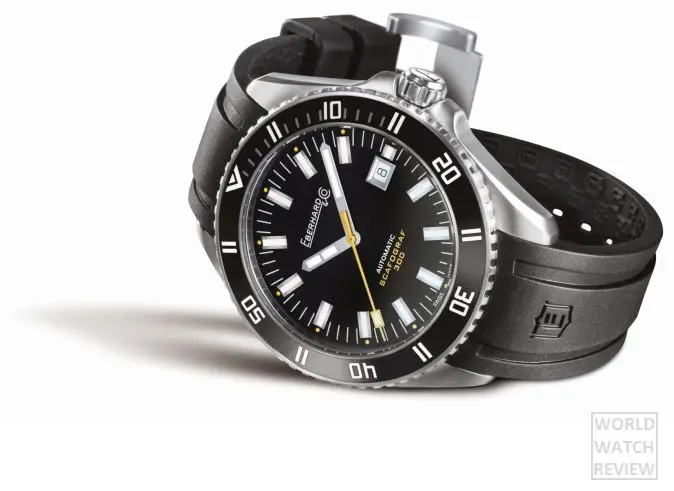
Even by today’s standards, the stainless steel case is not too big although some may find its long lugs not particularly convenient since they easily increase the case’s overall length by approximately ten millimeters to some 53 mm from lug to lug. If you happen to own a narrower wrist, you are in trouble. However, if you happen to be of more of an average build or even wider in the bones department, the case should probably fit nicely although I can’t call its profile especially well-sculpted.
It is interesting that the older Scafograf 300 from the 1950s didn’t have (and probably even didn’t need) a helium escape valve on its case. Although I can’t call the part a ‘gimmick’, I would probably have called it an overkill simply because this is not a professional diving tool and, truth be told, I can hardly imagine an owner of this definitely luxury timekeeper to often find himself (or herself, let’s not be misogynistic here) in a situation of peril where an extremely fast decompression would justify an introduction of the contraption.
On the other hand, the extra part at least, um, partly justifies the recommended retail price, which is nothing less than outrageous all things considered.
As far as the ergonomics are concerned, the Scafograf 300 excels in all departments starting with the winding/setting crown that is easy to operate even if you happen to have a set of stubby fingers and finishing with the unidirectionally rotating bezel with nicely finished notches that are wide and deep enough to provide solid grip without any sort of discomfort.
The luminescent markers on the first 15 minutes of the diving scale (including the stylized triangle at “00”,) too, help a great deal when you need to use the simple timer in a place where there just isn’t enough light (and in these sort of places you usually don’t want to find yourself with your oxygen tank depleted.)
The standard 21-mm wide black rubber band gives the diver an even sportier (and also more modern) appearance. Yet, it can also be had on optional stainless steel “Chassis” bracelet that looks similar to the original bracelet that the 1950s model offered. Please note that, while the bracelet comes with the brand’s patented “Declic” deployment clasp as standard, the rubber band is equipped with a lot less comfortable (and probably less secure if you indeed plan to use this watch as a diving companion) steel pin buckle: the aforementioned deployment clasp comes here as a more or less expensive option.
Dial
I have the impression that some fifty years ago when rock was hard, cars were deadly, and tool watches were, well, tools, people were less obsessed with what sort of personal statement they would like to make by changing the original strap for something ‘aftermarket’. Manufacturers, likewise, weren’t too busy looking for a piece of scrap metal that was used as a part of the hull of some doomed ship or a fighter jet but were mostly trying to create -again- a tool that would be good at doing its job. Making it more stylish and more interesting probably helped to sell more of them, but functionality and usability were a primary target for most designers.
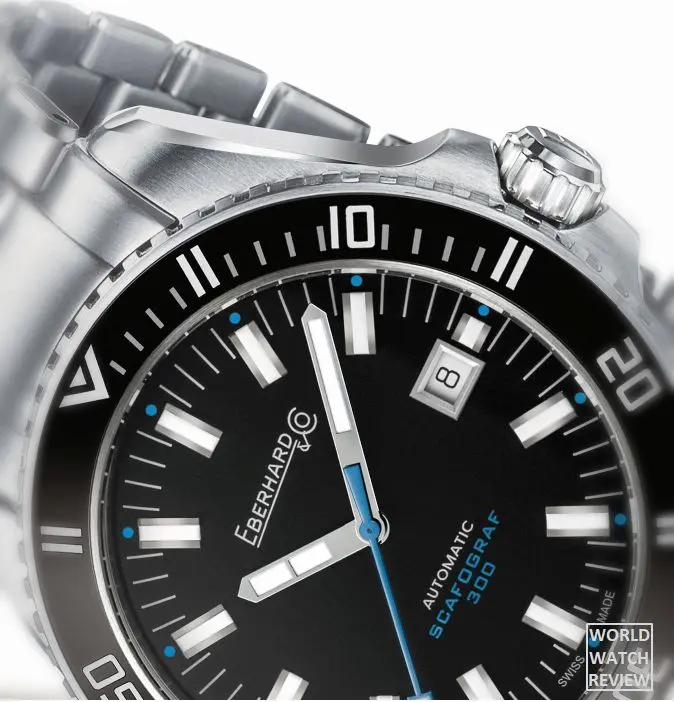
The original Scafograf series is a good example here. What it offered was a matt black dial with all three hands just wide enough to be easily read in any circumstances and simple enough to be produced on an industrial scale at a minimum cost. Surprisingly, they also looked extremely well (maybe it’s because we tend to like all things that are designed to do their job most efficiently, not just overwhelm us with complex shapes and exquisite decor.)
Yes, the layout was as simple as it was functional and the only thing where it lacked (and what the new model has inherited) was the absence of a fisheye lens over the small date window: although the indicator is not the most important element of the whole display, it would still be a lot easier to read if there was a small magnifying glass over the calendar aperture.
Compared to the original model that had its “main” markers at 6, 9, and 12 o’clock longer than the other eight, the new one has the indexes aligned more uniformly. Some may call the new layout soberer, some may call it duller. Looking at both, I am starting to think that I am probably with those who think that the older design was a tad more interesting: I think I like its somewhat imbalanced appearance.
Also, I don’t dig the tiny yellow (and they are also available in blue and white matching the color of the central-seconds hand) dots over the hour markers: they don’t add anything in terms of legibility and, fighting for your attention with other elements, even have a detrimental effect on your ability to read the time.
Besides these small annoyances, I would say that the dial is good when it comes to readability: the original design was so great that it was indeed difficult to ruin it with those timid attempts to make things look fresher.
Mechanism
This is, perhaps, the most boring part of this review. If you were expecting the watch that is offered at a retail price below $3000 to be powered by an in-house caliber with specs even slightly above the ordinary, you will probably be disappointed.
Like dozens and even hundreds of other Swiss-made three-handers from all sorts of brands out there, this model is animated by the well-known ETA 2824-2 blank caliber. Featuring an okay automatic winding system, being built on 25 jewels, and having its balance wheel beating at a standard rate of 28,800 semi-oscillations per hour, this is a movement of choice for a brand that aims to make a reliable timekeeper that would be easy to service in any part of the world and that would also be relatively inexpensive and easy to obtain in great numbers.
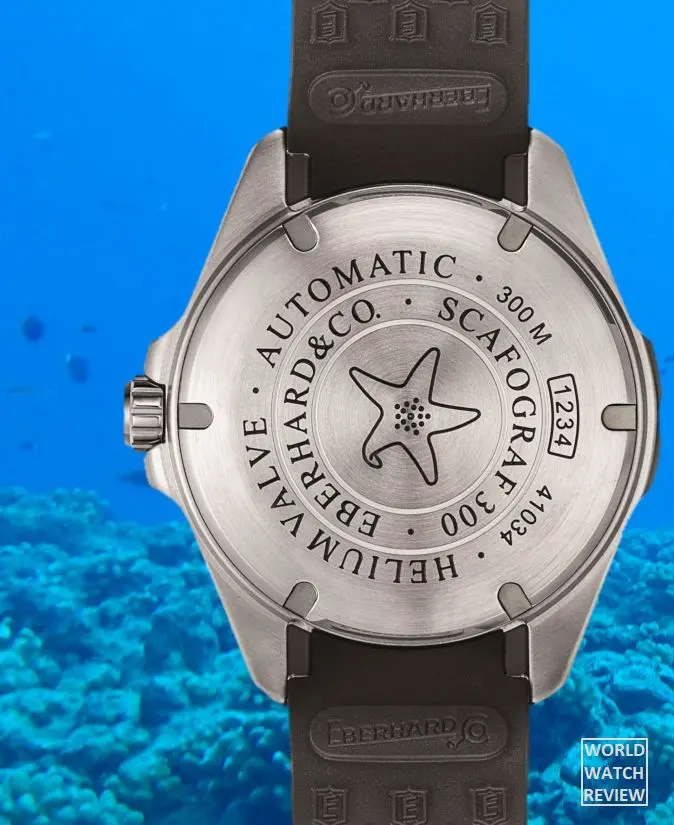
Again, the movement is as robust and reliable as it is boring and uninteresting. Like a true workhorse, it gets the job done, but, after your honeymoon with the new watch is over, won’t get a lot of attention besides the scheduled maintenance.
Probably, that’s precisely why Eberhard & Co. decided to hide the blank movement behind the solid screw-down case back cover (that and, probably, the fact that the original model, too, has had a solid back.) Well, at least the screw-down back is engraved with a stylized starfish, although the finish is not that impressive if your idea of a “nice” finish is closer to that of an Omega Seamaster, a lot less expensive Certina DS Action Diver or even their very own Scafodat 500 (Ref. 41025) back from 2013.
As far as I understand, the mechanism comes sans any sort of modifications or upgrades. However, in this price range, the calibers are usually more thoroughly regulated to increase their ability to keep a good time compared to those installed in cheaper timekeepers. Frankly, I don’t know whether Eberhard & Co. did invest time and money into fine-tuning the caliber.
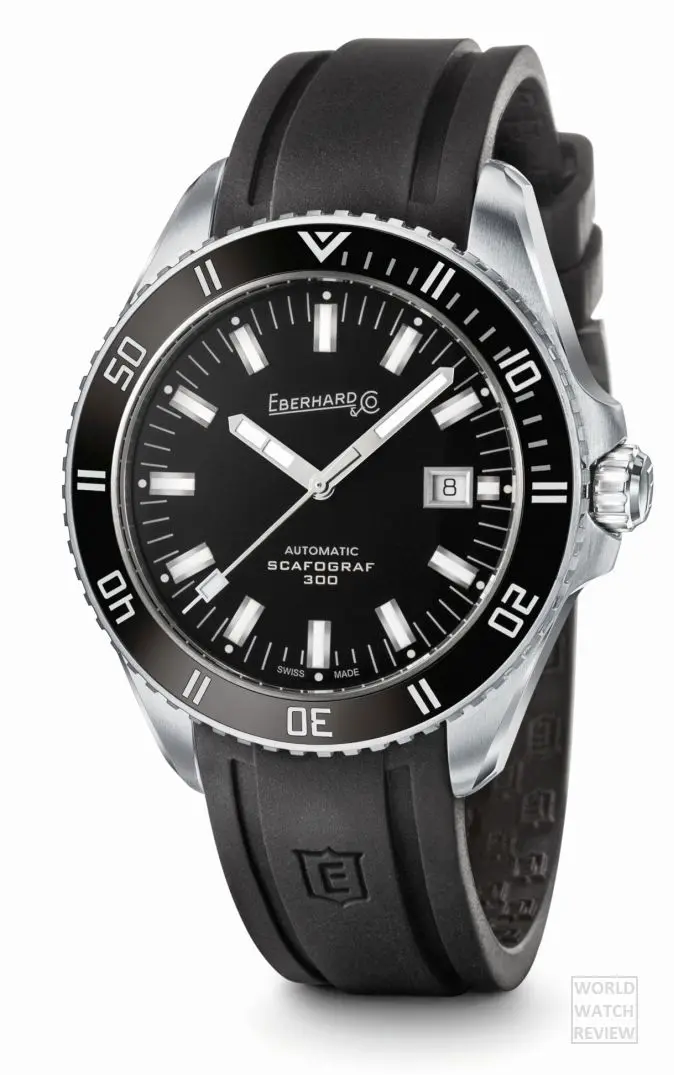
Pricing & Availability
Talking about expensive stuff, the Scafograf 300 will retail for some €2490 (MSRP, will vary in different parts of the world depending on local taxes and customs duties) and will be available in specialized stores later this year.
Again, I have the impression that this product is lamentably overpriced. Even though you can get yourself the aforementioned Certina DS Action Diver automatic three-hander that is powered by the same blank caliber and is still available for something like two-fifths of the MSRP, this “homage” is simply less interesting while being more expensive than the gorgeous Longines Heritage Legend diver that looks more original, is powered by a superior version of the same caliber and, for good measure, retails for about €300 less.
WWR Verdict
Originality 4/5
Build Quality: 5/5
Usability: 4.5/5
Overall Legibility: 4/5
Nighttime Legibility: 4.5/5
Value for Money: 3.5/5
Overall Rating: 4/5
See also: Alpina Seastrong Diver Heritage (refs. AL-525S4H6 & AL-525G4H6)
Photos: Eberhard & Co.
Eberhard & Co. Scafograf 300 (Ref. 41034) specification
Price: €2490 (MSRP)
Winding: Automatic
Movement: Caliber ETA 2824-2, Swiss Made
Number of jewels: 25
Movement frequency: 28,800
Power reserve: 38 hours
Functions: Hours, minutes, seconds, date
Case and Crown: Stainless steel
Bezel: Stainless steel with ceramic inlay
Shape: Round
Size: 43.00 mm
Case height: 12.60 mm
Lug width: 21 mm
Dial: Matt Black
Hour markers: Applied, luminous
Hands: Steel, luminous
Water resistance: 300 meters
Strap: Black rubber strap, branded with stainless steel buckle (Optional “Declic” deployment clasp) / Stainless steel “Chassis” bracelet with “Declic” deployment clasp
Crystal: Sapphire, convex, antireflective
Back: Solid, engraved
